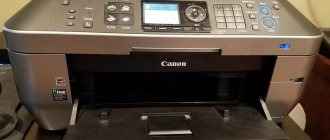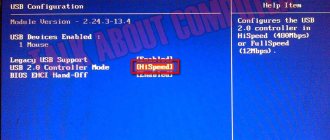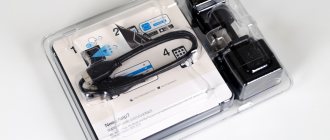Canon is once again joining the race of mirrorless camera manufacturers. This time in Japan they did not play by someone else’s rules, tacitly imposed on the mirrorless market by other players. The company went its own way. And together with the full-frame new Canon EOS R, it presented a new modular camera system that has every chance of world domination. With Canon's new RF mount, you can create lenses with previously unattainable performance. For example, a 50mm prime with an f/1.2 aperture or a 28-70mm zoom with an f/2 aperture. And all this is for a full frame.
Canon EOS R technologies
New Canon EOS RF mount
It would seem, why does Canon need another mount? After all, there is already a Canon EF-M, as well as EF-S and EF, which can be called partially compatible, since lenses for full-frame Canon EF also work on “cropped” EF-S mounts. However, there is logic in the appearance of a new product. Firstly, since the mirror has disappeared from the camera, you can reduce the working distance from 44 mm (Canon EF) to 20 mm (Canon RF). Secondly, 4 contacts were added to the mount, which improves communication between the lens and the camera. In practice, this made it possible to install a third, multifunctional ring on Canon RF lenses, improve power transfer, and embed image correction profiles directly into the lens, and not into the camera firmware.
It’s nice that when creating the Canon RF mount, the company thought not only about new customers. The new Canon EOS R modular camera system has several adapters available that allow you to connect lenses with EF and EF-S mounts to EOS R mirrorless cameras. The adapters support autofocus, and some models have a third ring and even pads for filters.
Canon EOS RF Lenses
Along with the new camera, several new lenses were introduced. Unfortunately, at the time of writing this article, the fleet of optics designed for Canon EOS R modular cameras includes only 4 models. Two primes and two zooms. Apparently, Canon tried to cover the most popular focal lengths, and other lenses will definitely appear later.
Canon RF 35mm f/1.8 MACRO IS STM is a lens with a fixed focal length of 35 mm. This is the most compact and affordable lens from the new line, which has an optical stabilizer and can be used in macro photography.
Canon RF 50mm f/1.2L USM - fifty dollars with a record (for full frame) f/1.2 aperture. This lens can be called an excellent example of what the company's engineers have become capable of when they do not have to adapt to the 44 mm flange distance.
Canon RF 24-105mm f/4L IS USM – every owner of Canon SLR cameras knows about a lens with a focal length of 24 – 105 mm. If you have a Canon camera, then most likely you have or have already owned such a lens. It belongs to the prestigious L series and shows a good range of focal lengths. Moreover, there is an image stabilizer - an excellent workhorse for every day.
Canon RF 28-70mm f/2L USM - apparently, this is a reincarnation of the famous Canon EF 24-70, only with an f/2 aperture instead of f/2.8. This is a good reportage lens with high aperture. However, like all such optics, it will not be cheap.
Dual Pixel CMOS AF system
At the time of writing this article, Canon's autofocus and focus tracking systems are the best. Thanks to Dual Pixel CMOS AF technology, phase focusing is carried out by the camera matrix. Each pixel consists of two photodiodes that separately read light signals. The results are then compared with each other, resulting in clear images even for moving objects.
In fact, Canon's autofocus system is rightfully considered one of the best in the world. Autofocus quickly and clearly catches objects or faces, and, most importantly, does not lose it from time to time, as happens with cameras from other manufacturers. It's nice that the EOS R has such an autofocus system, and even with 5,655 focusing points, which makes the camera an excellent tool for videographers.
Another important feature of the Canon EOS R's autofocus system is its night vision. The camera can focus in almost complete darkness, with brightness down to -6 EV (up to -6 stops of exposure). And it’s also worth noting the emergence of “manual tracking autofocus” - when the user can move a finger across the display, like on a laptop touchpad, and the camera will smoothly focus on the selected area.
Canon LOG movie mode
Canon's special LOG video mode will be appreciated by professional videographers. Using this mode, you can increase dynamic range by up to 800%, which prevents loss of detail in the brightest and darkest areas of the frame. The best news, however, is that the EOS R comes with Canon's LOG recording mode available by default—you don't have to pay extra to activate it. But to edit such a video you will need a very powerful PC, and work on color correction will be mandatory. However, to save time, you can get the useful Magic Bullet Colorista plugin, which can work with Canon LOG color.
⇡#Key features of EOS R
New mount. As with Nikon's new mirrorless cameras, the key innovation of the EOS R is its specially designed RF mount. It is created on the basis of the previous Canon EF standard, which was used in SLR cameras, and has the same diameter - 54 mm, but differs in a shortened working distance to 20 mm (compared to 44 mm for EF) and an increased number of contacts - from 8 to 12 Additional contacts are intended, in particular, to transmit data on lens aberrations to the image optimization system built into new cameras. Using the adapter released at the same time as the camera, you can install optics from the EF and EF-S series on the RF mount. Lenses like the Canon EF-M, created by the company for previously released mirrorless cameras, are not supported due to their shorter flange distance.
New optics. Along with the new camera, Canon introduced the first four lenses developed specifically for it: Canon RF 24-105mm f/4L IS USM, Canon RF 50mm f/1.2L USM, Canon RF 28-70mm f/2L USM, Canon RF 35mm f /1.8 Macro IS STM.
As we can see, the company is betting on the most popular focal lengths and aperture ratio. We were able to test the first two lenses from this list; most of the shots in the review were taken with them.
Adapters. Canon offers users a choice of three adapter options for using EF and EF-S optics with the new RF mount: a simple adapter, an adapter with a custom control ring, and an adapter with a filter slot. The latter is relevant when working with fisheye lenses, which, due to the convex front lens, do not allow the use of traditional filters.
New autofocus system. According to the manufacturer, the Canon EOS R uses the world's fastest hybrid autofocus system based on proprietary Dual Pixel technology. The stated autofocus response time is 0.05 s. Autofocus sensitivity is maintained in light levels as low as -6EV.
The number of focusing points is amazing - 5655 (for comparison: Nikon Z7 has 493 phase points, Sony A7 III has 683 phase and 425 contrast AF points). The camera has a face detection system, and there is also an eye autofocus function.
New controls. One of Canon's interesting developments, which has never been seen on any camera before, is a multifunctional touchpad-touchpad located on the back of the camera. The user can set the purpose of the touchpad independently, and you can configure touches separately on its left and right sides and sliding your finger along the panel.
In addition, RF lenses now have a control ring on which you can also “hang” a convenient function, such as changing the aperture.
New shooting mode. In the Canon EOS R, we see the Fv shooting mode for the first time. In essence, it is a well-known program mode in which shutter speed, aperture and ISO are set automatically by the camera, but there is an option to transform into Av or Tv mode at the user's choice: it is possible to manually set one or more parameters while automatically adjusting the rest.
Lack of internal stabilizer. This is a common occurrence for Canon cameras, but if you compare the new product with its closest competitors - full-frame mirrorless cameras from Nikon and Sony, the lack of a stabilizer looks somewhat unexpected.
Canon EOS R camera
If you are used to DSLR cameras, then most mirrorless cameras will seem awkward to you. Every modular camera manufacturer strives to make their solutions lighter and smaller. Therefore, if you hold the camera with a normal grip, the little finger of your right hand, as a rule, will slip off the body, and this is even in the best case. Working with a light and compact camera is always more pleasant than working with a heavy and large one, but only until the moment when its modest dimensions begin to harm more than help.
To avoid such situations, you can buy a battery grip, but this is an additional expense, and a considerable one. If holding the camera grip with all fingers of your right hand is important to you, the Canon EOS R won't disappoint. It has become lighter, more compact, and its height has changed slightly. Therefore, when you pick up the camera, you immediately get the feeling that this is a professional tool. Of course, “Heaviness is good. Heaviness is reliable,” but only up to a certain point.











